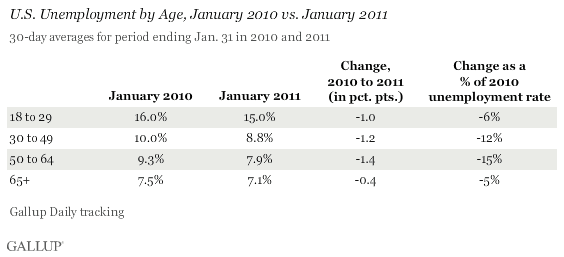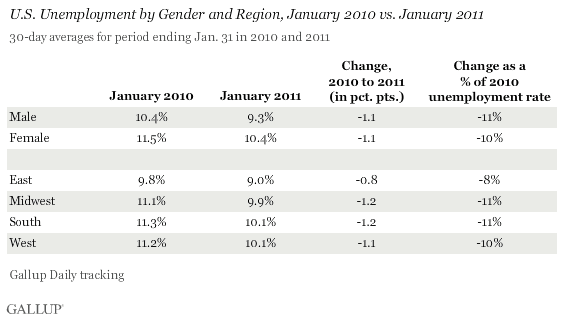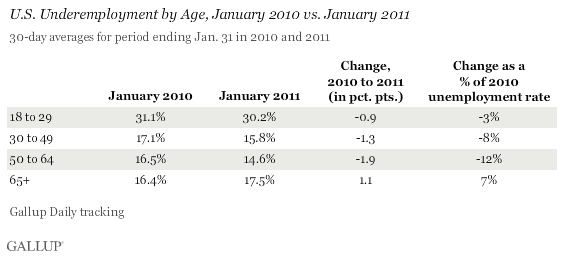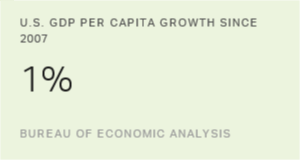PRINCETON, NJ -- Unemployment improved the most between January 2010 and January 2011 among Americans with a high school education or less, declining to 13.6% from 15.4%, and among those with postgraduate work, declining to 3.8% from 5.0%.
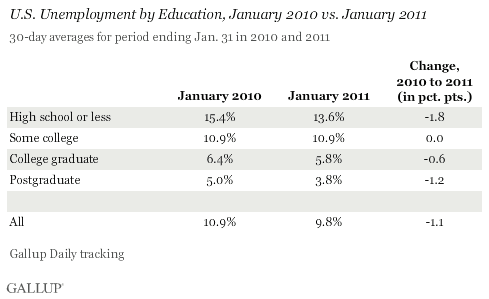
Year-over-year unemployment, as measured by Gallup without seasonal adjustment, improved to 9.8% in January 2011 from 10.9% in January 2010.
Underemployment Worsens for Americans With "Some College"
Underemployment -- a broader jobs measure that combines the percentage of part-time workers wanting full-time work and Gallup's U.S. unemployment rate -- shows a pattern by education similar to that of the unemployment rate. Those with a high school education or less and those with postgraduate work saw their underemployment rates decline the most. On the other hand, underemployment increased for those with some college, to 21.9% in 2011 from 20.9% in 2010.
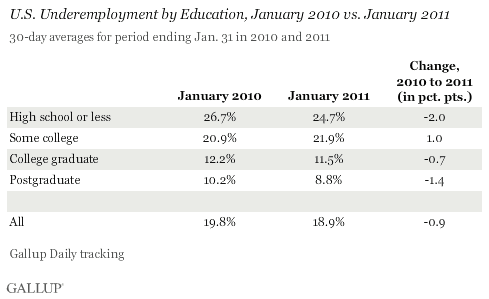
Education Key to Addressing Unemployment Challenges
Gallup's underemployment data illustrate the importance of education to the job market, and, simultaneously, some of the challenges associated with moving toward full employment of the current U.S. workforce. For example, Americans who have done postgraduate work have significantly lower unemployment, at 3.8%, and underemployment, at 8.8%, than their less-educated counterparts. The unemployment rate among this group has improved by 1.2 percentage points from January 2010 to January 2011 -- smaller in absolute terms than improvement among some other groups. However, when adjusted for the lower 2010 base of 5.0%, the rate of improvement for the most-educated group exceeds that of all other groups.
This aligns with another recent Gallup finding: more than 60% of small-business owners who hired fewer workers than they needed in 2010 say one reason they did so is an inability to find qualified employees. It also supports the idea that increased education is key to U.S. job growth -- particularly quality job creation -- in the future.
The 1.8-point improvement in unemployment and 2-point decline in underemployment among those with a high school education or less may indicate that current efforts to increase exports and manufacturing jobs are having some success. However, the January 2011 unemployment rate of 13.6% and underemployment rate of 24.7% among these workers suggests much more needs to be done to provide jobs and added education for today's less-educated workers if the U.S. is going to achieve a more normal unemployment rate.
The deterioration in the jobs situation facing Americans with some college leaves them with an underemployment rate of 21.9%, and suggests a need for added emphasis on finishing college. In turn, this implies a careful look at financial aid programs -- particularly given the financial challenges facing state budgets and state college programs.
Overall, today's roughly one-point year-over-year improvement in the real U.S. unemployment and underemployment rates is, at best, anemic. Even after this modest improvement, one in four Americans with a high school education or less and one in five with some college remain underemployed. Gallup's data suggest education is one of the essential levers that needs to be moved if this situation is going to change and quality job creation is going to accelerate going forward.
For data by age, gender, and region, please see page 2 of this report.
Gallup.com reports results from these indexes in daily, weekly, and monthly averages and in Gallup.com stories. Complete trend data are always available to view and export in the following charts:
Daily: Employment, Economic Confidence and Job Creation, Consumer Spending
Weekly: Employment, Economic Confidence, Job Creation, Consumer Spending
Read more about Gallup's economic measures.
View our economic release schedule.
Survey Methods
Gallup's U.S. employment measures report the percentage of U.S. adults in the workforce, aged 18 and older, who are underemployed and unemployed, without seasonal adjustment. "Underemployed" respondents are employed part time, but want to work full time, or they are unemployed. Results for each 30-day rolling average are based on telephone interviews with approximately 30,000 adults. Because results are not seasonally adjusted, they are not directly comparable to numbers reported by the U.S. Bureau of Labor Statistics, which are based on workers aged 16 and older.
Results are based on telephone interviews conducted as part of Gallup Daily tracking Jan. 2 to 31, 2011, with a random sample of 18,778 adults, aged 18 and older, living in all 50 U.S. states and the District of Columbia, selected using random-digit-dial sampling.
For results based on the total sample of national adults, one can say with 95% confidence that the maximum margin of sampling error is ±0.7 percentage points.
Interviews are conducted with respondents on landline telephones and cellular phones, with interviews conducted in Spanish for respondents who are primarily Spanish-speaking. Each daily sample includes a minimum quota of 200 cell phone respondents and 800 landline respondents, with additional minimum quotas among landline respondents for gender within region. Landline respondents are chosen at random within each household on the basis of which member had the most recent birthday.
Samples are weighted by gender, age, race, Hispanic ethnicity, education, region, adults in the household, cell phone-only status, cell phone-mostly status, and phone lines. Demographic weighting targets are based on the March 2010 Current Population Survey figures for the aged 18 and older non-institutionalized population living in U.S. telephone households. All reported margins of sampling error include the computed design effects for weighting and sample design.
In addition to sampling error, question wording and practical difficulties in conducting surveys can introduce error or bias into the findings of public opinion polls.
For more details on Gallup's polling methodology, visit www.gallup.com.
